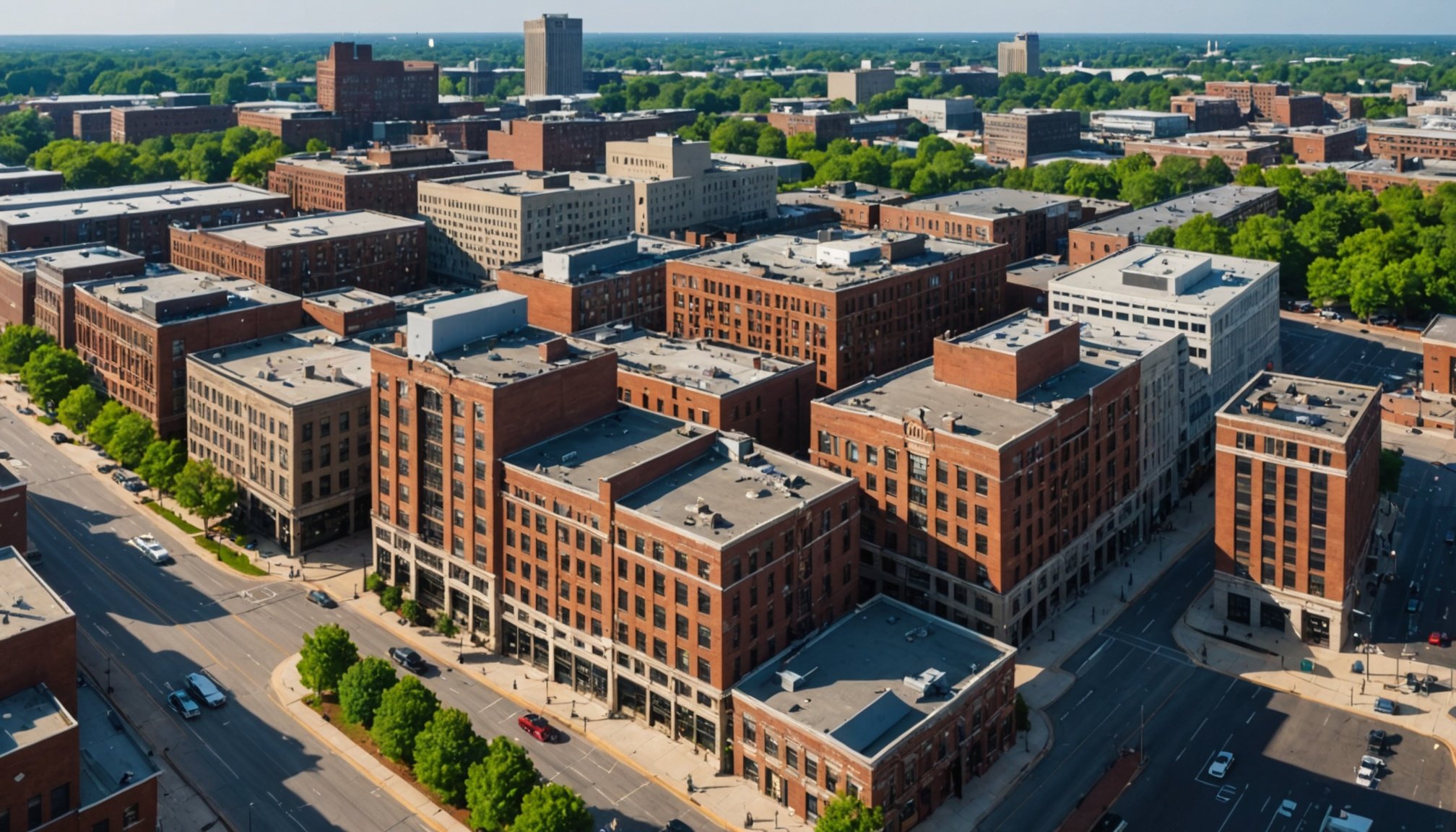Unveiling the Benefits and Drawbacks of Investing in Birmingham’s Diverse Urban Mixed-Use Projects
The Rise of Mixed-Use Developments in Birmingham
Birmingham, a city once known for its industrial heritage, is undergoing a significant transformation. The city is witnessing a surge in urban mixed-use developments, which are redefining the urban landscape and offering a plethora of investment opportunities. These projects combine residential, commercial, and recreational spaces, creating vibrant and self-sustaining communities.
Economic Growth and Job Creation
One of the most significant benefits of these mixed-use developments is their contribution to economic growth. By attracting businesses, restaurants, and entertainment venues, these projects create a ripple effect in the local economy. For instance, the expansion of industrial sectors in nearby areas like Bessemer has led to an influx of new businesses, including retail outlets, grocery stores, and restaurants, which in turn support the growing workforce and their families[1].
Also read : Unveiling the benefits and drawbacks of investing in real estate near uk tourist hotspots
- Creation of new job opportunities in various sectors
- Increased local spending and economic activity
- Attraction of national and local businesses
- Enhanced quality of life for residents
Urban Regeneration and Community Revitalization
Mixed-use developments are at the heart of Birmingham’s urban regeneration efforts. These projects often involve the repurposing of old storefronts and buildings, turning them into cafes, coworking spaces, and boutiques. This transformation not only enhances the aesthetic appeal of the area but also fosters a sense of community pride and entrepreneurship.
For example, the regeneration of Birmingham Smithfield by Lendlease includes plans for new homes, offices, and public spaces, which are set to revitalize the area and make it a desirable place to live and work[5].
In parallel : Unlocking brownfield redevelopment investment in the midlands: your essential funding guide
- Revitalization of neglected neighborhoods
- Creation of vibrant community spaces
- Encouragement of local entrepreneurship
- Improved public infrastructure
Sustainable Development and Green Infrastructure
As Birmingham grows, there is a growing emphasis on sustainable development and the preservation of green spaces. City planners and developers are working together to ensure that new projects incorporate green infrastructure and sustainable technologies.
Balancing Growth with Green Spaces
The rapid expansion of urban areas has raised concerns about the loss of natural habitats and green spaces. To address this, developers are incorporating green spaces such as community parks, walking trails, and playgrounds into new developments. Zoning regulations are also being adapted to encourage higher-density developments close to industrial hubs, reducing the need for outward expansion and conserving land[1].
- Incorporation of community parks and green spaces
- Preservation of natural habitats and wetlands
- Use of sustainable technologies like solar panels and green roofs
- Encouragement of mixed-use buildings to reduce environmental footprint
Climate Change and Low Carbon Initiatives
Birmingham is committed to reducing its carbon footprint, and new developments are reflecting this commitment. Many new buildings are designed with energy-efficient systems, smart water management, and renewable energy solutions. These initiatives not only align with sustainability goals but also attract environmentally conscious buyers and renters, adding long-term value to properties.
For instance, the use of green roofs, energy-efficient HVAC systems, and solar panels in new construction projects is becoming more common, contributing to a more sustainable urban environment[1].
- Implementation of energy-efficient systems
- Use of renewable energy solutions
- Incorporation of green roofs and smart water management
- Reduction in long-term operational costs
Challenges and Drawbacks
While mixed-use developments offer numerous benefits, they also come with their share of challenges and drawbacks.
Infrastructure and Public Services
The growth in population and industrial activity puts a strain on the city’s infrastructure and public services. Utilities such as water, sewage, and electricity face the challenge of supporting a larger and more industrially active community. Developers are working with local governments to upgrade these systems, often incorporating sustainable technologies to reduce long-term operational costs[1].
- Pressure on utility systems
- Need for infrastructure upgrades
- Potential for increased traffic congestion
- Strain on public transportation
Regulatory Hurdles and Community Resistance
Regulatory debates and community resistance can pose significant hurdles to new developments. For example, the Birmingham City Council is currently debating regulations for short-term housing rentals, with discussions around capping the number of rentals, requiring special exceptions, and mandating courses for rental owners[2].
- Regulatory uncertainties
- Community resistance to new developments
- Potential caps on short-term rentals
- Need for special exceptions and approvals
Practical Insights and Actionable Advice
For investors and developers looking to venture into Birmingham’s mixed-use projects, here are some practical insights and actionable advice:
Engage with Local Communities
Engaging with local communities and understanding their needs and concerns is crucial. This can help in building support for new projects and ensuring that they align with the community’s vision for the area.
- Conduct community outreach programs
- Collaborate with local stakeholders
- Incorporate community feedback into project designs
Focus on Sustainable Development
Investing in sustainable technologies and green infrastructure not only contributes to environmental stewardship but also adds long-term value to properties. Developers should prioritize energy-efficient systems, renewable energy solutions, and green spaces in their projects.
- Incorporate energy-efficient systems
- Use renewable energy solutions
- Include green spaces and sustainable technologies
Work Closely with Local Governments
Working closely with local governments can help navigate regulatory hurdles and ensure that projects align with the city’s planning and zoning regulations. Developers should stay updated on local policies and engage in constructive dialogue with city officials.
- Stay informed about local regulations and policies
- Engage in dialogue with city officials
- Collaborate on infrastructure upgrades
Investing in Birmingham’s diverse urban mixed-use projects offers a myriad of benefits, from economic growth and community revitalization to sustainable development and green infrastructure. However, it also comes with its share of challenges, including infrastructure pressures and regulatory hurdles.
By understanding the intricacies of these projects, engaging with local communities, focusing on sustainable development, and working closely with local governments, investors and developers can navigate these challenges and contribute to the city’s ongoing transformation.
As Nancy Ruddy, co-founding Principal and Executive Director of Interior Design at CetraRuddy, noted, “You can be in Midtown in 20 minutes,” highlighting the appeal of mixed-use developments in urban areas. Birmingham’s journey towards becoming a smart, sustainable, and vibrant city is an exciting one, and investing in its mixed-use projects can be a rewarding and forward-thinking decision[3].
Table: Comparative Analysis of Mixed-Use Development Benefits and Challenges
| Aspect | Benefits | Challenges |
|---|---|---|
| Economic Growth | Creation of new job opportunities, increased local spending, attraction of businesses | Potential strain on local resources, regulatory uncertainties |
| Urban Regeneration | Revitalization of neglected neighborhoods, creation of vibrant community spaces | Community resistance, need for special exceptions and approvals |
| Sustainable Development | Incorporation of green spaces, use of renewable energy solutions, energy-efficient systems | Higher initial costs, need for advanced technologies |
| Infrastructure | Upgrades in public infrastructure, improved utilities | Pressure on utility systems, potential for increased traffic congestion |
| Community Engagement | Enhanced quality of life for residents, community pride and entrepreneurship | Need for community outreach and feedback incorporation |
| Regulatory Environment | Alignment with city planning and zoning regulations | Regulatory debates, potential caps on short-term rentals |
Quotes and Perspectives
- “The reason is we keep on hearing from our professional staffers that we have a housing shortage, and all of our complaints that we receive are from residential areas,” – Abbott, discussing the need for careful regulation of short-term rentals[2].
- “You can be in Midtown in 20 minutes,” – Nancy Ruddy, highlighting the appeal of mixed-use developments in urban areas[3].
- “Balancing development with green space is essential for Bessemer’s future. Residents, developers, and policymakers must work together to ensure that the city remains a place where economic growth and environmental responsibility thrive side by side,” – Emphasizing the importance of sustainable development[1].
By considering these perspectives and insights, investors and developers can make informed decisions that contribute to the sustainable and economic growth of Birmingham.

